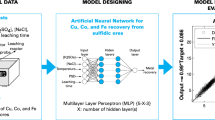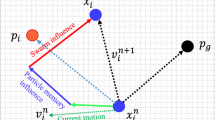Abstract
Metal recovery prediction of elements remains as one of the significant problems in the metal industry due to limited application data. In this research, quasi-Newton training algorithm-based artificial neural network (ANN) was applied for estimating the recovery amount of the elements during the anode slime emerging processes. ANN models were designed with the approximation of the inverse Hessian at each iteration by using gradient information. Temperature, leaching time, solid-to-liquid ratio and ionic liquid concentration were taken as input parameters for the recovery amount estimation. The results showed that the proposed algorithm is highly efficient in predicting metal recovery amount from anode slime. As a precious one, maximum Au recovery amount is predicted by ANN as 82.11% when the solid-to-liquid ratio is 1/25, the temperature is 45 °C, ionic liquid concentration is 40% and the leaching time is 0.5 h.






Similar content being viewed by others
References
Abd El-Ghaffar MA, Abdel-Wahab ZH, Elwakeel KZ (2009) Extraction and separation studies of silver(I) and copper(II) from their aqueous solution using chemically modified melamine resins. Hydromet 96(1–2):27–34
Aguilera EM, Vera MCH, Viñals J, Seguel TG (2016) Characterization of raw and decopperized anode slimes from a Chilean refinery. Metall Mater Trans B 47(2):1315–1324
Bogaers AE, Kok S, Reddy BD, Franz T (2014) Quasi-Newton methods for implicit black-box FSI coupling. Comput Methods Appl Mech Eng 279:113–132
Chen Y, Liu N, Ye L, Xiong S, Yang S (2018) A cleaning process for the removal and stabilisation of arsenic from arsenic-rich lead anode slime. J Clean Prod 176:26–35
Hait J, Jana RK, Sanyal SK (2004) Mineralogical characteristics of copper electrorefining anode slime and its leached residues. Ind Eng Chem Res 43(9):2079–2087
Han J, Liang C, Liu W, Qin W, Jiao F, Li W (2017) Pretreatment of tin anode slime using alkaline pressure oxidative leaching. Sep Purif Technol 174:389–395
Huang J, Chen M, Chen H, Chen S, Sun Q (2014) Leaching behavior of copper from waste printed circuit boards with Brønsted acidic ionic liquid. Waste Manag 34(2):483–488
Khademi F, Jamal SM, Deshpande N, Londhe S (2016) Predicting strength of recycled aggregate concrete using artificial neural network, adaptive neuro-fuzzy inference system and multiple linear regression. Int J Sustain Built Environ 5(2):355–369
Khashman A (2012) An emotional system with application to blood cell type identification. Trans Inst Meas Control 34(2–3):125–147
Kılıç Y, Kartal G, Timur S (2013) An investigation of copper and selenium recovery from copper anode slimes. Int J Miner Process 124:75–82
Kilicarslan A, Saridede MN, Stopic S, Friedrich B (2014) Use of ionic liquid in leaching process of brass wastes for copper and zinc recovery. Int. J Miner Metall Mater 21(2):138–143
Noack MM, Funke SW (2017) Hybrid genetic deflated Newton method for global optimisation. J Comput Appl Math 325:97–112
Park J, Jung Y, Kusumah P, Lee J, Kwon K, Lee CK (2014) Application of ionic liquids in hydrometallurgy. Int J Mol Sci 15(9):15320–15343
Rüşen A, Topçu MA (2017a) Optimization of gold recovery from copper anode slime by acidic ionic liquid. Korean J Chem Eng 34(11):2958–2965
Rüşen A, Topçu MA (2017b) The effect of EmimHSO4 (1-ethyl-3-methyl-imidazolium hydrogen sulfate) on copper recovery from anode slime AKU-J. Sci Eng 17:696–703
Wang S, Cui W, Zhang G, Zhang L, Peng J (2017) Ultra fast ultrasound-assisted decopperization from copper anode slime. Ultrason Sonochem 36:20–26
Welton T (1999) Room-temperature ionic liquids. Solvents for synthesis and catalysis. Chem Rev 99(8):2071–2084
Whitehead JA, Lawrance GA, McCluskey A (2004a) ‘Green’leaching: recyclable and selective leaching of gold-bearing ore in an ionic liquid. Green Chem 6(7):313–315
Whitehead JA, Lawrance GA, McCluskey A (2004b) Analysis of gold in solutions containing ionic liquids by inductively coupled plasma atomic emission spectrometry. Aust J Chem 57(2):151–155
Whitehead JA, Zhang J, Pereira N, McCluskey A, Lawrance GA (2007) Application of 1-alkyl-3-methyl-imidazolium ionic liquids in the oxidative leaching of sulphidic copper, gold and silver ores. Hydrometallurgy 88(1–4):109–120
Whitehead JA, Zhang J, McCluskey A, Lawrance GA (2009) Comparative leaching of a sulfidic gold ore in ionic liquid and aqueous acid with thiourea and halides using Fe(III) or HSO5 − oxidant. Hydrometallurgy 98(3–4):276–280
Xing WD, Lee MS (2017) Leaching of gold and silver from anode slime with a mixture of hydrochloric acid and oxidizing agents. Geosyst Eng 20(4):216–223
Yildizel SA, Tuskan Y, Kaplan G (2017) Prediction of skid resistance value of glass fiber-reinforced tiling materials. Adv Civ Eng 2017:1–8
Zhang FY, Zheng YJ, Peng GM (2017) Deselenization and detellurization of precious-metal ore concentrates by swelling oxidizing roasting and successive alkaline leaching. Int J Miner Metall Mater 24(2):147–155
Acknowledgements
The authors gratefully acknowledge the Karamanoğlu Mehmetbey University Scientific Research Projects (BAP) Coordinating Office for support with Grant Number KMU-BAP-04-YL-16.
Author information
Authors and Affiliations
Corresponding author
Ethics declarations
Conflict of interest
The authors certify that they have no affiliations with or involvement in any organization or entity with any financial interest (such as honoraria; educational grants; participation in speakers’ bureaus; membership, employment, consultancies, stock ownership, or other equity interests; and expert testimony or patent-licensing arrangements) or nonfinancial interest (such as personal or professional relationships, affiliations, knowledge, or beliefs) in the subject matter or materials discussed in this paper.
Additional information
Editorial responsibility: M. Abbaspour.
Rights and permissions
About this article
Cite this article
Rüşen, A., Yildizel, S.A. & Topçu, M.A. Metal recovery prediction of elements from anode slime. Int. J. Environ. Sci. Technol. 16, 6797–6804 (2019). https://doi.org/10.1007/s13762-019-02224-7
Received:
Revised:
Accepted:
Published:
Issue Date:
DOI: https://doi.org/10.1007/s13762-019-02224-7




